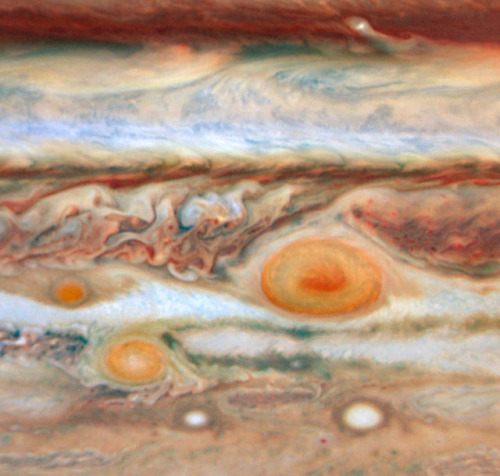Neptune♆









Neptune♆
Neptune is the planet of mystery and allusion. Its power is that of imagination. Neptune represents your dream life and your mystic qualities. It is the planet of bewitchment. Anyone who has had an artistic vision, or is drawn to spiritual matters, or has experienced an unusual and unexplainable event has felt the power of Neptune. Neptune’s realm is the subconscious world, hidden memory, intuition and clairvoyance. Neptune’s power is subtle, ethereal, inspirational, and otherworldly.
More Posts from Sidusglacies and Others



Blanet: A new class of planet that could form around black holes
The dust clouds around supermassive black holes are the perfect breeding ground for an exotic new type of planet.
Blanets are fundamentally similar to planets; they have enough mass to be rounded by their own gravity, but are not massive enough to start thermonuclear fusion, just like planets that orbit stars. In 2019, a team of astronomers and exoplanetologists showed that there is a safe zone around a supermassive black hole that could harbor thousands of blanets in orbit around it.
The generally agreed theory of planet formation is that it occurs in the protoplanetary disk of gas and dust around young stars. When dust particles collide, they stick together to form larger clumps that sweep up more dust as they orbit the star. Eventually, these clumps grow large enough to become planets.
A similar process should occur around supermassive black holes. These are surrounded by huge clouds of dust and gas that bear some similarities to the protoplanetary disks around young stars. As the cloud orbits the black hole, dust particles should collide and stick together forming larger clumps that eventually become blanets.
The scale of this process is vast compared to conventional planet formation. Supermassive black holes are huge, at least a hundred thousand times the mass of our Sun. But ice particles can only form where it is cool enough for volatile compounds to condense.
This turns out to be around 100 trillion kilometers from the black hole itself, in an orbit that takes about a million years to complete. Birthdays on blanets would be few and far between!
An important limitation is the relative velocity of the dust particles in the cloud. Slow moving particles can collide and stick together, but fast-moving ones would constantly break apart in high-speed collisions. Wada and co calculated that this critical velocity must be less than about 80 meters per second.
source


Moon (Jun. 23, 2020)

新幹線と富士山 (via かがみ~)





Saturn and Neptune by Voyager II
A rendering (Motion Edit) of a thunderstorm, based on a single photograph of a cumulonimbus cloud lit by a lighting, captured by night from an airliner at 40,000ft (12,000m), visualize a towering cumulus convection emerging from an altocumulus cloud cover.

An altocumulus cloud cover from below.

And the angel said, “DO NOT BE AFRAID.”

The faint rings of Uranus, shot in 1986, are made of countless fragments of water ice containing radiation-altered organic material.
Credit: NASA/JPL/Michael Benson, Kinetikon Pictures

the truth is out there
-
 seekcrisis liked this · 1 month ago
seekcrisis liked this · 1 month ago -
 lasirenedesiree liked this · 7 months ago
lasirenedesiree liked this · 7 months ago -
 uniquedreamrunaway liked this · 11 months ago
uniquedreamrunaway liked this · 11 months ago -
 kerrydawn82 liked this · 11 months ago
kerrydawn82 liked this · 11 months ago -
 moonlitsass liked this · 1 year ago
moonlitsass liked this · 1 year ago -
 breakcorebracken liked this · 1 year ago
breakcorebracken liked this · 1 year ago -
 astrosin reblogged this · 1 year ago
astrosin reblogged this · 1 year ago -
 papurikahareruya liked this · 1 year ago
papurikahareruya liked this · 1 year ago -
 tioletnonuare liked this · 1 year ago
tioletnonuare liked this · 1 year ago -
 blackbirdie1022 reblogged this · 1 year ago
blackbirdie1022 reblogged this · 1 year ago -
 hiwagacherryblossom liked this · 1 year ago
hiwagacherryblossom liked this · 1 year ago -
 sweetiepieve reblogged this · 2 years ago
sweetiepieve reblogged this · 2 years ago -
 berriblingz liked this · 2 years ago
berriblingz liked this · 2 years ago -
 crispylungs liked this · 2 years ago
crispylungs liked this · 2 years ago -
 catalystzel liked this · 2 years ago
catalystzel liked this · 2 years ago -
 peachy-lutin liked this · 2 years ago
peachy-lutin liked this · 2 years ago -
 miaowng liked this · 2 years ago
miaowng liked this · 2 years ago -
 lunarpiscesworld liked this · 2 years ago
lunarpiscesworld liked this · 2 years ago -
 baberuthless23 liked this · 3 years ago
baberuthless23 liked this · 3 years ago -
 nevada1949 liked this · 3 years ago
nevada1949 liked this · 3 years ago -
 pianovels liked this · 3 years ago
pianovels liked this · 3 years ago -
 mami1000-blog reblogged this · 3 years ago
mami1000-blog reblogged this · 3 years ago -
 mami1000-blog liked this · 3 years ago
mami1000-blog liked this · 3 years ago -
 fanatramena liked this · 3 years ago
fanatramena liked this · 3 years ago -
 venusianight reblogged this · 3 years ago
venusianight reblogged this · 3 years ago -
 apageintotheoblivion liked this · 3 years ago
apageintotheoblivion liked this · 3 years ago -
 moonlaced liked this · 3 years ago
moonlaced liked this · 3 years ago -
 thisismy56universe liked this · 3 years ago
thisismy56universe liked this · 3 years ago -
 bluelagoontycoon liked this · 3 years ago
bluelagoontycoon liked this · 3 years ago

